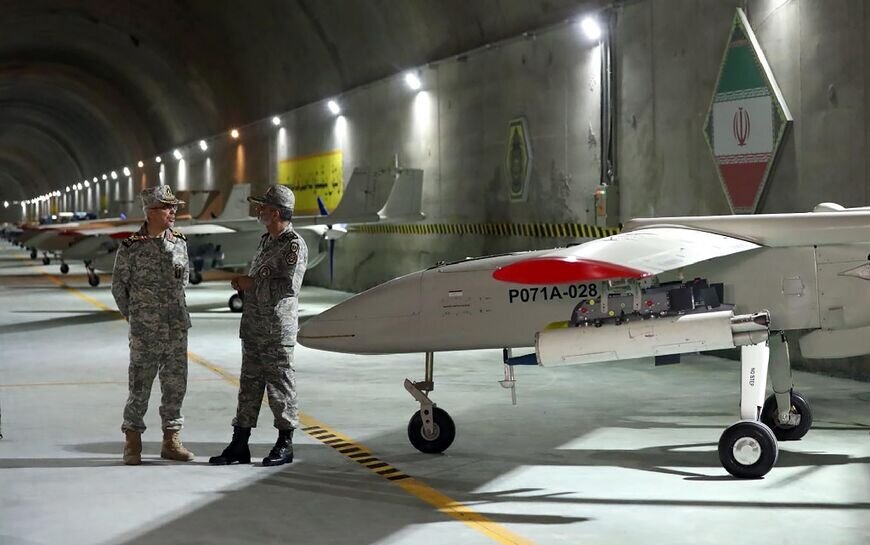Designed for a variety of military applications, these drones emphasize the continued promotion of self-sufficiency in unmanned aerial systems amidst sanctions and local tensions.
In his remarks at the announcement ceremony, Brigadier General Nozar Nemati, deputy commander of the Iranian Army’s ground forces, recognized the demands of modern battlefields and the urgent need to invest in advanced technologies such as micro aviation vehicles, drones, unmanned systems and artificial intelligence.
He said the Iranian military is fully committed to the development of indigenous peoples of these strategic capabilities.
“Because of the continued investment, planning, research, and the advancement and development of such efficient and empowering fields, the Army’s ground forces are now recognized as the major and pioneering forces in the employment of new defense and military outcomes and the use of power,” he said.
What is a VTOL drone?
Vertical Takeoff and Landing (VTOL) drones offer greater advantages than traditional drones thanks to their ability to take off and land vertically, eliminating the need for runways, rocket boosters, tube launches, ramps, platform vehicles, or other equipment.
This versatility makes it suitable for a wide range of applications and environments. The most common VTOL configurations include wingless multi-rotors, winged tilt rotors, and hybrid VTOLs.
VTOL drones generally tend to be heavier. This is because smaller military drones (usually less than 10 kilograms) can be manually fired.
VTOL drones excel in environments with limited space and in urban, mountainous and maritime environments where traditional take-off and landing are unrealistic.
The hybrid VTOL design combines vertical takeoff and fixed wing flight, achieving longer flight times compared to multi-rotors, making it ideal for reconnaissance, surveillance, mapping and delivery in extended areas.
In Iran’s Islamic Republic, the Navy is a major user of VTOL drones, as most ships do not have the space for traditional drone takeoff and landing, except for large drone carriers.
What is a Homa Vtol drone?
HOMA is a VTOL (vertical takeoff and landing) drone designed specifically for reconnaissance missions, focusing on electronic warfare scenarios.
Its name comes from the legendary mythical bird of Iran.
Unless new additions to Iranian military service, the HOMA VTOL drone was first observed in naval operations in the summer of 2022. It appeared in drone exercises for the next few months and was reported in the spring of 2023 among 200 newly distributed units.
The VTOL variant is an evolution of the original HOMA drone, featuring traditional takeoffs and landings. The first HOMA models introduced in early 2015 came in two sizes: the smaller HOMA-1 and the larger HOMA-2. These designs were developed based on the American RQ-7 shadow drone that crashed in Iran in 2005.
Early Homa drones introduced a high-wing constant cord pusher layout with twin tail boom patience and twin vertical stabilizers mounted on top of horizontal stabilizers.
This configuration is also a feature of other Iranian drones, such as the Meraj and Mohajer series, as well as several models other than HOMA.
The HOMA VTOL version employs a hybrid design by integrating the square system. Four rotors are attached to two forward expansion booms, replacing traditional patience with an inverted V-Tail.
This VTOL setup has been adopted similarly in small Iranian naval drones such as the Pelikan-2 (dispatched in 2019) and Chamrosh-4 (introduced in 2023), as well as Meraj-2 (dispatched in 2021).
Previous Homa VTOL drones had a pusher propulsion system for horizontal flight, but recent images reveal a move to a tractor configuration using a front-mounted propeller.
The main specifications of the Homa VTOL drone include a 5.54-meter wingspan, 120 kg empty weight, a payload capacity of up to 40 kg and a maximum takeoff weight of 260 kg.
It can reach speeds up to 200 km/h, operate within a 100 km radius, fly at altitudes up to 3,600 meters, and maintain a 10-12 hour flight.
Built primarily for intelligence newsletters, HOMA VTOL drones may support naval operations by providing real-time data in contested environments.
The ability to operate effectively in electronic warfare conditions suggests the existence of measures against jamming and radar detection.
Dideban and Shahin-1 Vtol Drones
The Iranian military has also announced two additional VTOL drones. One is a typical folding quadcopter, and the other is a fixed wing drone with fuselage and wings, each with two propellers.
This fixed wing model takes off vertically before moving to horizontal flight.
Assigned to the Iranian Army ground forces, the Didevan VTOL drone is a lightweight portable platform designed primarily for reconnaissance and precision targeting.
The name, which means “watchdog,” emphasizes its role in surveillance and situational awareness. The Dideban has both daytime and nighttime capabilities, providing greater versatility across a variety of operating conditions.
The Dideban can accurately locate the target and is ideal for guiding strikes and artillery fire, so it operates at a maximum altitude of 1,800 meters, but at an altitude suitable for tactical missions.
The outstanding feature is that it can fly in coordinated groups and monitor and target multiple areas at the same time. This herd’s ability could overwhelm the enemy’s defenses and provide comprehensive battlefield coverage, reflecting modern drone tactics.
The Shahin-1 (Falcon-1) VTOL Drone is a first-person view (FPV) Kamikaze platform designed for high-speed, precision strikes.
Built to counter the “danger of future battles”, Shahin-1 focuses on evolving combat scenarios by surgically attacking enemy targets such as military facilities, vehicles and personnel.
Equipped with FPV control, operators can guide Shahin-1 with high accuracy, ensuring effective hits on both fixed and mobile targets.
Although certain endurance and range figures are private, drones boast high speed and maneuverability, allowing them to execute quick and accurate strike missions in a variety of operational contexts.
Source: presstv
MNA/

